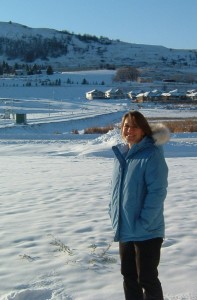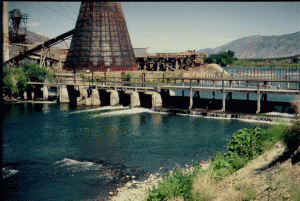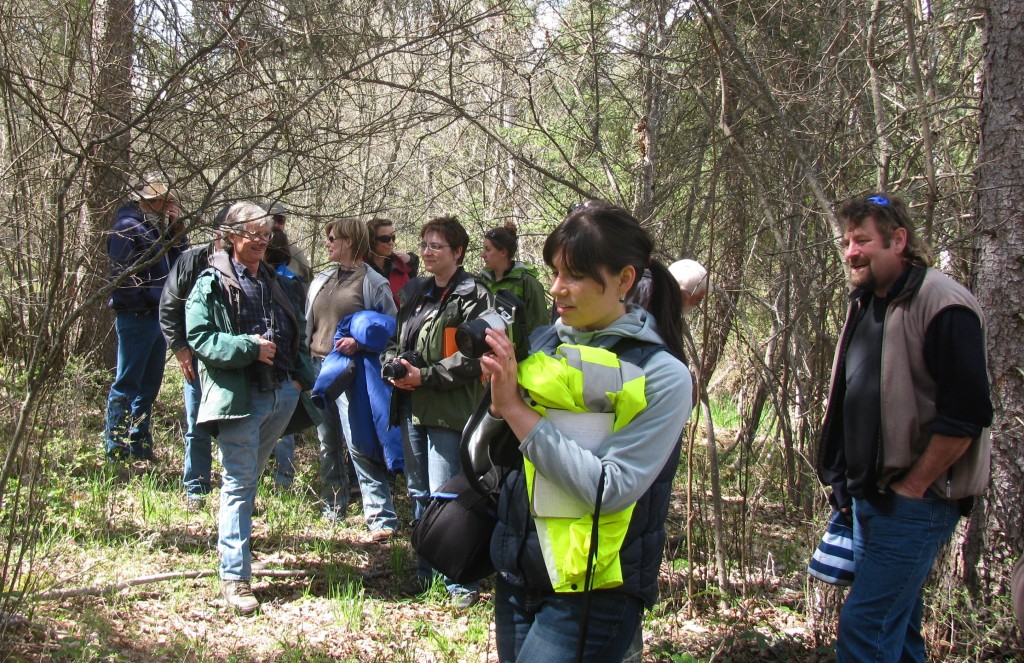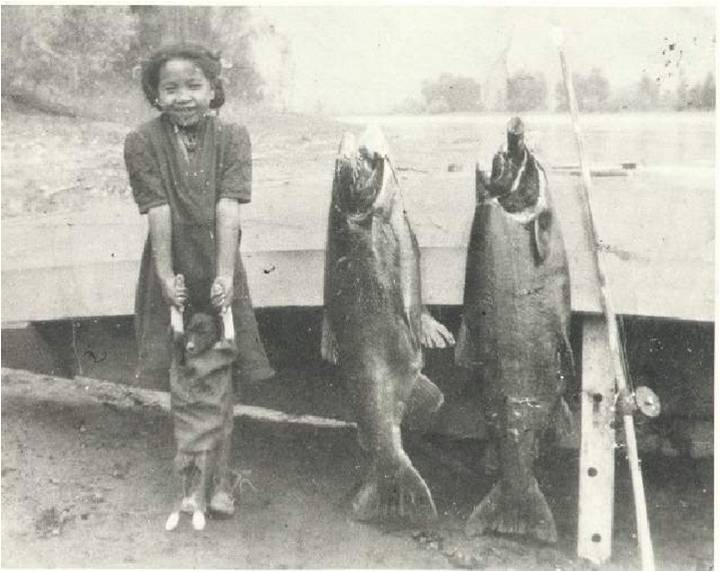Category Archives: Updates
No vacation in the Salmon Nation
“All men are equal before fish.” – Herbert Hoover
Last week, I attended a workshop in Portland, Oregon, on the future of salmon under climate change. Our delegation had been invited to talk about the resurgence of sockeye in the Okanagan River, and our experiences with collaboration. Scientists, managers, fishers, First Nations, and other friends of fish, gathered from around the north Pacific to talk about good news, bad news, and what’s possible. It was a diverse group from far-flung geography, bound together by the need to manage salmon under rapidly changing conditions.
And while much of the conversation was focused on science, there was an important thread about values. What we protect and care for depends strongly on what we value as communities.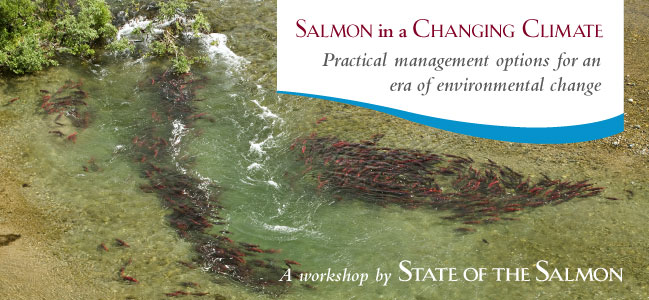
While there is uncertainty about the impacts of climate change in specific salmon areas, almost all models project the same outcome: warming waters, summer and winter. Warmer summer waters interfere with spawning, rearing, and migration – and can lead to fish kills in oxygen-poor water. Warmer waters in winter (particularly in the ocean) could expand the range of salmon to the north as the sea ice breaks up; but this wouldn’t replace the loss of salmon to southern ecosystems and communities. Continue reading
Rocks, computers, and other water tools for distributed networks
“We shall neither fail nor falter; we shall not weaken or tire…give us the tools and we will finish the job.” – Winston Churchill
I once read about a farmer in Africa who’s land was bare, eroded and cracked by drought. Without many alternatives, he tried an ancient practice of piling small rows of rock along the contour of the slope. The rocks slowed overland flow from short cloudbursts, and captured dust and seeds from the wind. Within a season he could see the land begin to recover. It is a simple, effective technique now being used around the world.
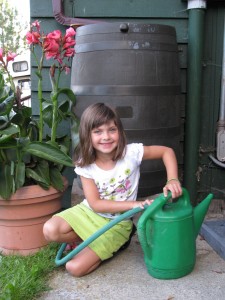
Okanagan old timers talk about how most people used to have rain cisterns for drinking water. Now, rain barrels supplement irrigation water in urban back yards, and divert water that might otherwise enter the storm system.
For a while after reading this, I walked around saying “we need more stone-age solutions!” Really, it’s about appropriate technology: sometimes you need a rock, sometimes a satellite.
As information and communication become more integrated (What was life like before the internet?), distributed networks are emerging as powerful components of our social system. Rather than Big Brother gathering data and taking top-down action, responsibility is shared.
It’s happening politically (the Arab Spring, the “Occupy” movement, and the BC trend to localize planning and decision-making), and it’s happening with resource management. With less funding and capacity from the central governments, we must figure out how to protect water quality, water supplies, and the health of the ecosystem by organizing the contributions of individuals across the region. Continue reading
Simple, home-grown solutions for the Osoyoos international water agreement.
“When it is obvious that the goals cannot be reached, don’t adjust the goals, adjust the action steps.” – Confucius
It is hard to think of anything more controversial than “Americans taking our water.” Questions come up at almost every public meeting. The concerns are not entirely unfounded: in general (as Trudeau famously remarked), living next door to the US is a lot like sleeping next to an elephant – feeling every twitch and grunt. This underlying sentiment, and the need to meet Okanagan water demand and environmental flows while being good neighbours, has created intense interest in the renewal of the International Joint Commission’s (IJC) agreement for Osoyoos Lake.
In this post, I want to share our “Made in the Okanagan” solution for the 2013 renewal of the Osoyoos Lake Operating Orders for Zosel Dam.
The orders’ main goals are to control floods and prevent water shortages. But everyone wants more certainty about water supplies on both sides of the international border – including water for the Okanagan’s reviving sockeye run. The reach most at issue for the US is the short stretch of river between the dam and its confluence with the mighty Similkameen River. While “certainty” may be out of reach in this era of environmental change, I feel we’ve come up with a strong set of action steps to get to our (bilateral) goals. Continue reading
Good mussels, bad mussels, and environmental triage
“In conclusion…there is a high risk of [zebra mussels] not only surviving in some parts of Okanagan Lake, but a high potential for massive infestations.” – Gerald L. Mackie, 2010
Sometimes we need to do environmental triage – focusing on what’s most important, and what approaches are likely to succeed.
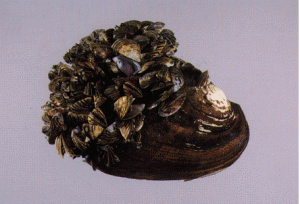
When water conditions are right, zebra mussels reproduce rapidly and can completely cover the shells of native mussels.
Lately I’ve been trying to get a better understanding of the situation with mussels in the lakes. There are two of immediate concern – a species native to the Okanagan, the Rocky Mountain ridged mussel, on the verge of local extinction, and an invasive – the zebra mussel, which is spreading rapidly across North America and heading this way.
These species are an example of how we grapple with management approaches and trade-offs, and the best course for protecting biodiversity for the whole ecosystem. Continue reading
From vision to action with environmental grantmaking
“A town is saved, not more by the righteous men in it than by the woods and swamps that surround it.” – Henry David Thoreau
Resources take many forms. To make real changes in a watershed, money is often far less important than having a strong, networked community and a shared vision. In the Okanagan, we are using small amounts of funding in strategic ways to build community capacity and reinforce our sense of interconnectedness.
Water communication: making water visible.
“If you’re not part of the solution, you’re part of the precipitate.”
Steven Wrightfont
I’ve been thinking lately about the incredibly complexity of our water systems. Any town or city, treating millions of gallons of drinking water, pumping it to our homes, then pumping it back for re-treatment and recycling. Millions of gallons – out of sight, out of mind – taken completely for granted.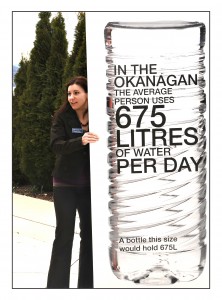
It was a matter of civic pride to have these invisible systems, a sign of progress, where at the turn of a tap, water (hot and cold) arrives instantly at any sink in the house. Now, funnily enough, every municipality has a water awareness campaign emphasizing the value of water and how people need to get informed, stop wasting water, and reduce pollution. We are busy making water visible again.
An international watershed board for Osoyoos Lake?
“As I looked down, I saw a large river meandering slowly along for miles, passing from one country to another without stopping. I also saw huge forests, extending along several borders. And I watched the extent of one ocean touch the shores of separate continents. Two words leaped to mind as I looked down on all this: commonality and interdependence. We are one world.” – John-David Bartoe, astronaut
The one time I went to a reunion with my grandmother, I couldn’t get over how much these new-found relatives looked just like me (big smiles, round faces). My family had doubled in size overnight. That’s the feeling I had this week at the bi-national Osoyoos Lake Water Science Forum. Our Canadian maps may stop at the 49thparallel, but the basin continues south and includes a larger watershed family. If we are going to use the slogan, “One Valley, One Water,” we have to think bigger.
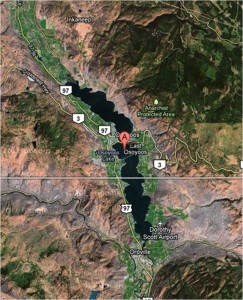
Osoyoos Lake from space, where the distinctions blur between where one jurisdiction begins and another ends.
Alex Louie, who filmed the proceedings for the Osoyoos Indian Band, reminded the group that from the indigenous point of view, the international border doesn’t exist. The Colville Confederated Tribes are the same people as the Okanagan Nation. Looking around the room, you could mostly say the same about the residents of Oroville and Osoyoos (the U.S. and Canadian towns along the lakeshore), or even the visiting university and agency people – shared values, shared backgrounds, shared interests.
There’s no question that Osoyoos Lake will be healthier if we can take a common, ecosystem-based approach to water quality and water supply problems. Lake levels, flow rates, watermilfoil control, shoreline access and zoning all lend themselves to collaborative processes. On the other hand, we can’t just throw nationhood and politics out the window.
Water (ironically enough) is a highly inflammatory issue. Continue reading
Osoyoos Lake: Live
“It starts with the water. If you don’t have good water, the plants and animals will tell us we aren’t doing our job…They are an important part of our family – if a place doesn’t have plants and animals, it won’t have humans.” – Chief Clarence Louie, Osoyoos Lake Water Science Forum, September 18, 2011.
Welcome to the Salmon Nation. One day into the Osoyoos Lake Water Science Forum and my head is filled with fish. For thousands of years, the Okanagan people fished sockeye here. They are salmon people – with a territory stretching south to Oregon and north and east through the southern interior of BC. We are here in Osoyoos this week to talk about a lot of different issues, but none more symbolic and integrative than the return of the sockeye.
The Osoyoos sockeye run is the eastern frontier for fish coming up the Columbia. The run used to reach far up the system, but dozens of smaller dams interrupted the passage. Last night, Chief Clarence Louie told a story about how when the Grand Coulee dam was completed, they invited the chiefs and dancers to come and celebrate in their regalia. “There is a picture of all these chiefs, standing and looking at the dam, and I just think, how sad that is, how mad and disappointed those chiefs must be, knowing that the dams have taken away the salmon.”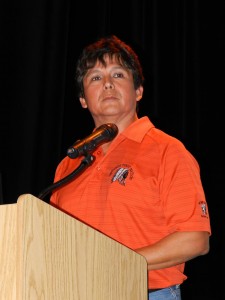 Continue reading
Continue reading
Water Stewardship for the 21st Century
“The creation of the Water Stewardship Council is a significant action in advancing water conservation and quality…” – Greg Selinger, premier of Manitoba, on the national Water Stewardship Council (June 2011).
I think we might be going back to the future with our new paradigm of watershed collaboration. Having the right people in the room has always been a recipe for good government (probably before the Romans and Greeks…). What may be new is formally using collaboration to improve our resource management.
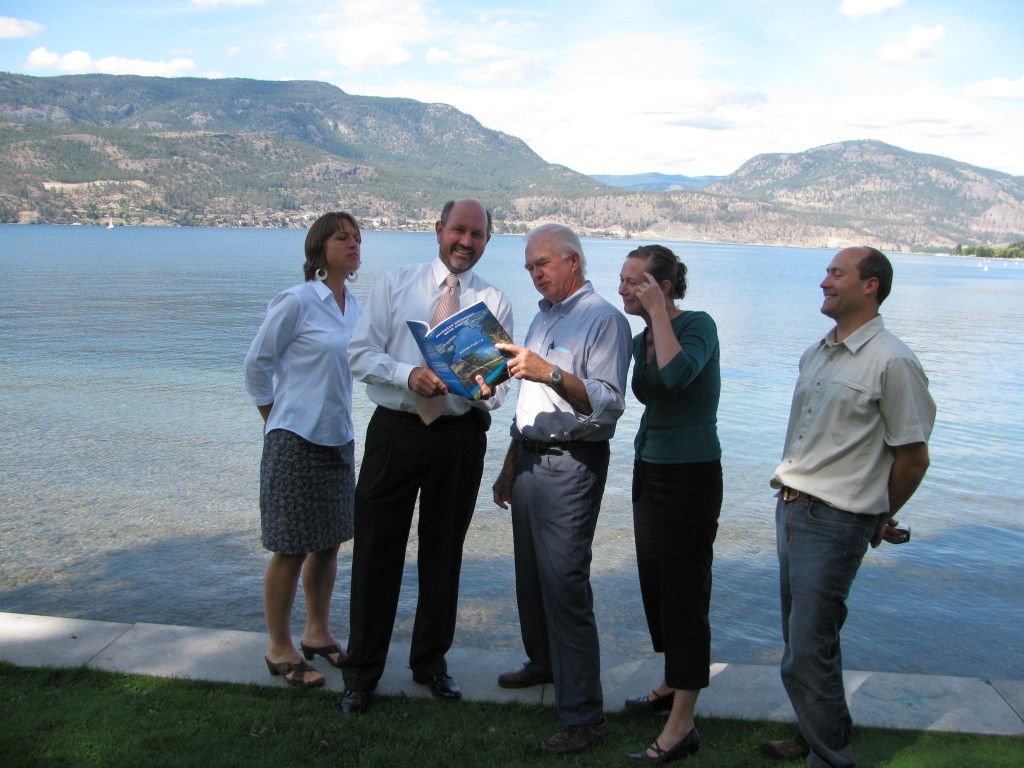
Goofing around at a photo-shoot for the Sustainable Water Strategy - From L to R: Anna Warwick Sears, Bernie Bauer, Tom Siddon, Kellie Garcia, and Nelson Jatel.
And let’s put “new” in quotes. The Okanagan’s Water Stewardship Council, Ontario’s Conservation Authorities and Alberta’s Watershed Planning and Advisory Councils have been on the landscape for decades. But never mind that. Ten years into the 21st century, this idea is coming of age. Continue reading

